642 ideas what to draw - sketchbook.
642 Things To Draw.
A very unusual book. In fact, it's not a book at all! This sketchbook, sketchbook. Not a mini album, as sketchbooks usually are, but a weighty one. This is long enough! It is possible that for years, because the same task (if you do not immediately occupy all the space allotted for the drawing, but leave a little space for the future) can be performed several times. Or - draw with the whole family! The paper here is very high quality, thick, drawing ( not loose, as in ordinary children's albums), you can draw not only with a pencil, but also with pens and felt-tip pens, oil pastels.
The beauty of this book is that it invites you to draw the most unexpected things, even such as you ( especially for a child) would never have occurred to ask yourself to draw. At the same time, the artist must be able to draw anything: from a unicorn and a DNA molecule to a toothbrush, cotton swab, and sworn friends with first love. We train! We will also be asked to draw a scream, a sense of humor, and fresh air. Makes you smile! That being said, the book provides some serious training; even an experienced draftsman will be a little puzzled by some of the tasks here.
The book unfolds well, the pages inside are held firmly.
But the children, surprisingly, the tasks do not bother at all. Even complex ones. They can always express their idea of a phenomenon or object. Difficulties arise only when an unfamiliar word is encountered. This is an opportunity to talk and explain. We replenish vocabulary, develop imaginative thinking.
To make it easier for children to start drawing here, first you take the book yourself, open it, preferably at the very beginning, and boldly draw what is given. On the first page we have cookie cutters and a hammock. picture anything, even if you don’t know how to draw at all and hold a pencil for the first time since childhood. Then the children will save you - they will seize the initiative and draw themselves. But getting started is hard the book is good, sorry!), So kids need help- initiate drawing process, which then can not be stopped.
Children's drawing - lollipop.
Thanks to this book, you understand that you can draw not only objects that are understandable to everyone (there are many such tasks in the book, we will practice with different things), but also abstract concepts, and even some things that are impossible to depict on paper! Inspirational book! Opens your eyes to art in a new way. And in the paintings it becomes interesting to find where and how the artist depicted the wind here? Or warm. Or something else that I never thought of before.
For children, the album solves the problem, draw. Children always draw with joy if they know what; but they have one big problem - it's hard to solve, What exactly draw. Everything is simple here: we open it on any page, read the tasks, scroll through, choose what we would like to depict now. Or you can just go through the book from the very beginning, page by page, without missing a single task. Do not know, How draw this? You can look at photos, books, and create your own image.
It's great that here no picture hints, otherwise fantasy is limited to simple redrawing. Here you need come up with your own, to decide how exactly we will draw this or that object or phenomenon. It is difficult, but incomparably more useful. If you (or a child) think about how to draw, for example, a caterpillar, a constellation, playing cards, or just a watering can, then you will not forget it, and most likely you will be able to express the image with at least several different options. This is the work of an artist, illustrator, designer. Not just draw, but think and draw. Like no one else has ever painted.
The tasks in the book begin immediately.
For adults, the book allows you to train creative thinking and practice drawing on a variety of subjects. The tasks in the book are constantly interspersed: not that first objects, then phenomena, but all mixed up, so you don’t get tired of drawing something of the same type, you constantly have to switch from the conceivable to the unthinkable and fantasize.
For those who are learning to draw, this is not a book, but a real teacher. Everything ingenious is simple, and this album is proof of that. Simple and whole. Not a list of tasks on a piece of paper and scattered sheets and albums, and not an album with given sketches for redrawing, a whole book which we draw ourselves day by day. And you can - the whole family. And thanks to the book format, the book is convenient to store on a shelf in a bookcase.
For experienced draftsmen, this book poses unusual challenges and provides an opportunity to learn how to create at a new level.
The very first tasks are cookie cutters and a hammock.
If you draw always and everywhere, if your sketches are scattered in notebooks and notebooks and it seems to you that you have already drawn everything that is possible, and there are no new ideas left, then this notebook will be a real gift for you! (Notepad is putting it mildly, the book is big!).
On the pages - 642 original and witty ideas of what to draw... and, of course, a place to draw.
The tasks are arranged differently: for some, a whole page is left, somewhere the page is divided into two or more parts - along, across, or even diagonally. Division is always logical: if there is a lollipop and a guitar on the page in the tasks, the page for them is divided along - for tall and long objects.
In a notebook, you can draw yourself, practicing your technique or testing your abilities ( Will you be able to draw everything that is written? ..). Can i collect drawings of friends in a notebook. This is great: let everyone who comes to the house draw something here, complete one of the tasks, leave their name and date under the drawing. This book will be a real story!
A book for children from 8 years old and all adults who love to draw.
205x260 mm, a little over 300 pages, and no introductions: drawing sheets immediately after the first title page. And to the very end. A small description is on the back of the book.
Book ( for the album) is quite expensive, however - if you think carefully, 300 pages of quality drawing paper, firmly bound into a single book (good binding, the book unfolds, but the pages do not fall out), will also cost a lot. Example - an album of everything for 50 sheets(for professional drawing, too good paper). Already not cheap. And here in the book of pages - much more, at times.
Publisher: Mann, Ivanov i Ferber. 2015
A regular album is good for completing assignments in art school or for work (if you are an artist, illustrator, designer), but This book is for recreation and leisure.. For creativity. It is very good as a purchase before a trip, for example, to summer camp for children: then all friends will be able to draw in the book, sign the drawings, then it will remain as a keepsake.
Printed in Lithuania, circulation 3000 copies.
Example ideas from this book (a small part, because ideas here, as stated on the cover, as many as 642), from the very beginning and further in order: cookie cutters, hammock, anchor, dog, rocking chair, Van Gogh's ear ( for children it will do to draw any ear), sandwich, musicians, ottoman, corkscrew, emergency exit, whales, dacha, bushes, mushrooms, pigtails, dinner party, bubbles, fangs, pickles, laundry, dolphin, button, wind pipe, dessert... And so on.
642 ideas of what to draw, photo book pages
A little description on the back of the book.
floating candle, children's drawing.
sworn enemies. Not an easy task. The child decided to portray his favorite dolls, which (according to legend) do not like each other: Toralei and Cleo de Nile. It remains only to trace and color the Toralei, but we don’t have Cleo yet, she will be finished later when the doll appears.
Examples of some spreads of the book. The pages are divided differently, the tasks are printed finely, they do not interfere with drawing.
Drawing to the very end! On the last page - Me!
You can draw with the whole family, children can color the drawings of adults, etc. This is a game and learning at once. Here - the child has painted the cookie cutters drawn on the hastily an adult who can't draw.
Knee socks and a robot are drawings by a 6-year-old child in this book.
- Draw freely! Find yourself with an art diary
- creative education
- Creative education: how to find a common language with children
- creative education
- colorful nature
- I am an artist! Color the masterpiece
- visual notes. Sketchnoting
- You will be able to draw in 30 days
- look book. creative scrapbook for fashion girls
- Creativity with kids
- Fashion Design: Art Books
- How to draw fashion models of clothes?
- Fantasarium. Everyone can draw
- Do whatever you want! Scribble
- creative year
When we bought this book, we thought that there would be text, ideas for drawing, etc. inside. and when they opened the book and saw empty pages, they were so surprised! And it turned out to be much more interesting when it already says what needs to be drawn (otherwise I just sometimes want to draw, but I don’t know what, but now there will be no problems with this).
Worth taking? I want to take my daughter. Like a trainer. Recently, they began to find out why she sometimes works well and quickly at the ISO, and sometimes frankly stupid. It turns out that there is a problem with some tasks, they didn’t fall into her wave and she doesn’t know what to do with them. When this book came across in the announcements, I was intrigued. Like the second book in the What to Write series
Hm. It'll come in handy! And then at school I suffer during breaks, and I think what to draw, ato some Magiks, but I draw Madzhiks :-)
If almost 700 g of weight does not scare you, you can take a book to school and generally always carry it with you. Plus a pencil, eraser, and sharpener. Even on the bus it is convenient to draw if you go for a long time.
Celeste, I think my daughter should be fine. Mine has about the same trouble: he draws with joy, but sometimes problems arise - he wants to draw something, but he doesn’t know how, and then everything crumples and flies into the trash. There is no such problem with the book - initially it is treated as a training one, so he looks at the books, sometimes asks for help, draws here things that he does not know how and do not work out. Even without an eraser, because there is study, not effort. Then it's easier in your drawings.
But I have not yet seen what to write a book. Also probably something interesting, judging by this one. Then surprise teachers with unexpected essays. :-))
My favorite subject is horses. At least she draws them. But with the given topics. I come to pick her up for the last time from the fine arts (from detention), and she has a uniform hysteria. We find out what the matter is, it turned out that she does not know how to make a costume out of fabric for a doll. Our topic is this. A doll is molded from polymer plasticine and a medieval costume is sewn for her. As a result, I persuaded the teacher to give home to finish. That's right, a digression.
As for the book, 632 an idea of what to write. In the description they write that the beginnings of 632 stories are given and it is necessary to come up with a plot development or ending for them. Something like that
And mine is crazy about horses, draws them both cartoon and real. But many other topics need to be tightened up. Now, let's train.
Alexander Bogatov, illustrator and graphic designer from Izhevsk, shared his search methods great ideas for illustrations and graphic design.
My name is Sasha Bogatov - illustrator, graphic designer from Izhevsk. developing my own project Daily sketchups- daily illustrations, where the emphasis is on working with meanings, mixing techniques and styles, tools.
There is no time to wait for a muse when you are leading a similar project and working at the same time. Therefore, I delved into the search for methods for generating ideas. As a result, I have a certain list of techniques that I use often. Generating ideas is not magic. This is a skill that can be pumped. You can download, for example, using the methods listed below.
The article does not contain the following techniques: brainstorming and its variations; six Edward De Bono hats; TRIZ. Much has been written about them, it makes no sense to retell.
1. Idea generator generator
Victor Melamed, head of the illustration course at the British Higher School of Design, posted on Facebook about inventing generators to generate images.
Description and mechanism of work. Inside the generator: current, transformer, tester. Tok - What inspires you: apple ponytails, raccoon tails, horror movie posters, English porcelain. Transformer - transformation of source material into plots, ideas. Tester - criteria emerging from the requirements of the tasks by which we will evaluate the generated ideas.
“A good generator should produce different ideas within the same logic and not burn out before the fifth idea. Good idea not only memorable and intriguing, but also triggers the plastic development of the picture"
V. Melamed.
Types of generators:
● Transformer - transforming a situation into a plot
● Inverter - objects are swapped
● Collider - when there are two current sources
● Randomizer - random constants
● Incubator - when you need to detail a fictional world
● …
You can always come up with generators with your own parameters, go for it! A table with generators is attached to the post. The generators were described by the students of the Melamedov course using the examples of their favorite illustrators, as well as their own developments.
Transformer; current No. 1 - people, animals, objects; current №2 - contrast of sizes; tester - absurd plausibility. Illustration - Brad Holland, description of the generator - Alyona Belyakova.
 inverter; current - any objects and animals; a transformer - attribute or part of a creature or object is alienated from it and used for other purposes; tester - unusual and funny. Illustration - Brock Davis, description of the generator - Victor Melamed.
inverter; current - any objects and animals; a transformer - attribute or part of a creature or object is alienated from it and used for other purposes; tester - unusual and funny. Illustration - Brock Davis, description of the generator - Victor Melamed.
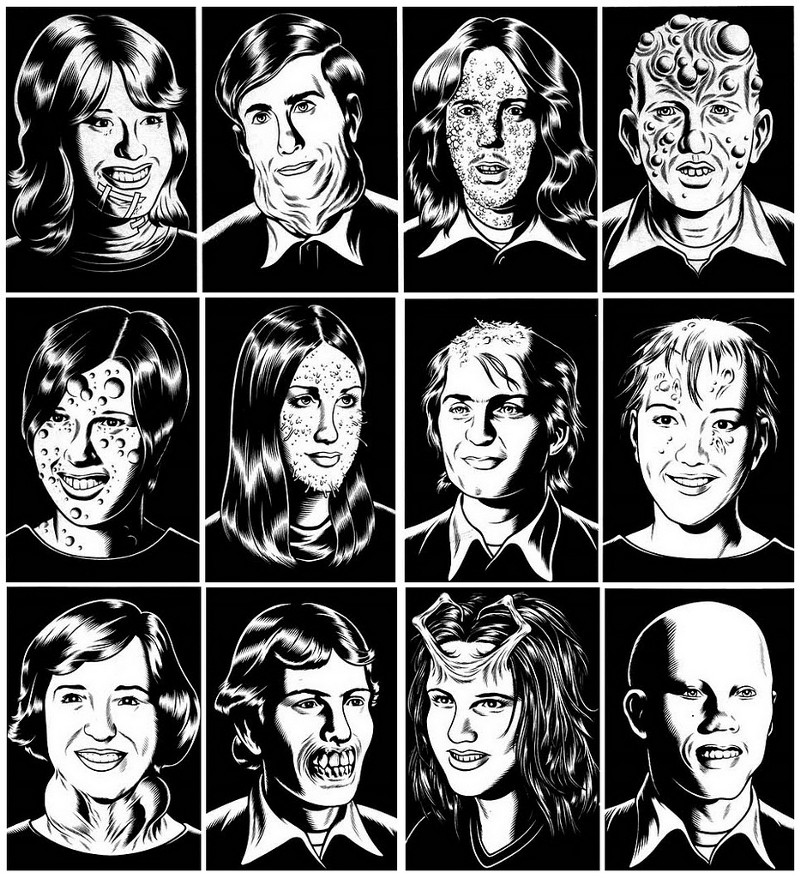 Collider; current №1 - photos of graduates, any genres of everyday photography; current No. 2 - persons from horror; transformer - collision; tester - mocking horror. Illustration - Charles Burns, description of the generator - Anastasia Sukharkova.
Collider; current №1 - photos of graduates, any genres of everyday photography; current No. 2 - persons from horror; transformer - collision; tester - mocking horror. Illustration - Charles Burns, description of the generator - Anastasia Sukharkova.
 Randomizer; current - five words beginning with the same two letters; transformer - combining into a plot.Illustration - Wren Mcdonald; illustration context - troll tromping tropical trombone troopers trolley; description of the generator - unknown.
Randomizer; current - five words beginning with the same two letters; transformer - combining into a plot.Illustration - Wren Mcdonald; illustration context - troll tromping tropical trombone troopers trolley; description of the generator - unknown.
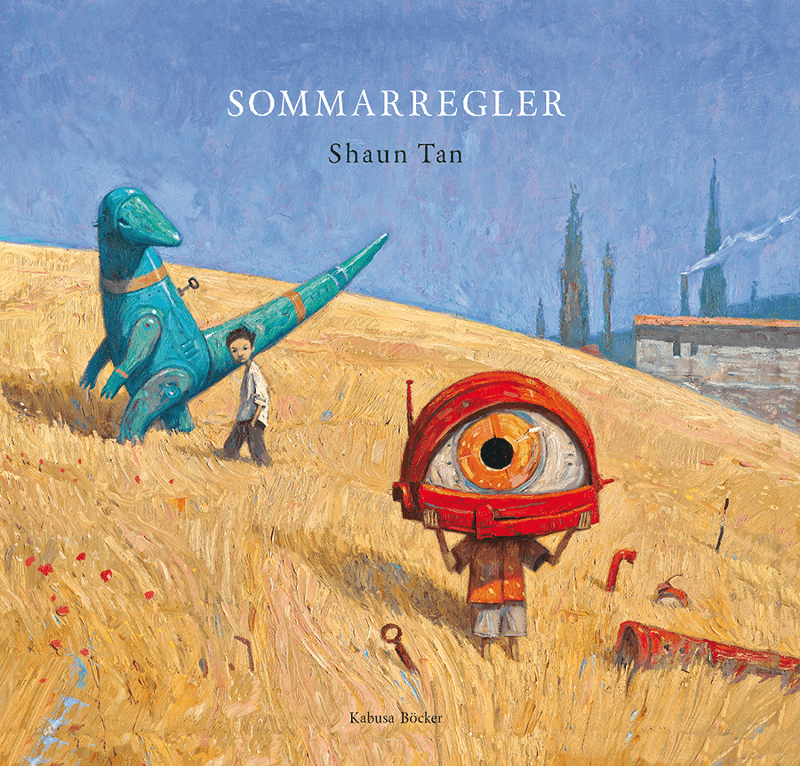 Incubator; current No. 1 - everyday situations, current No. 2 - animals; transformer - the world of children and intelligent robots representing animals; tester - warmth, peace, surrealism.Illustration - Shaun Tan (Rules of summer), description of the generator - Anastasia Sukharkova.
Incubator; current No. 1 - everyday situations, current No. 2 - animals; transformer - the world of children and intelligent robots representing animals; tester - warmth, peace, surrealism.Illustration - Shaun Tan (Rules of summer), description of the generator - Anastasia Sukharkova.
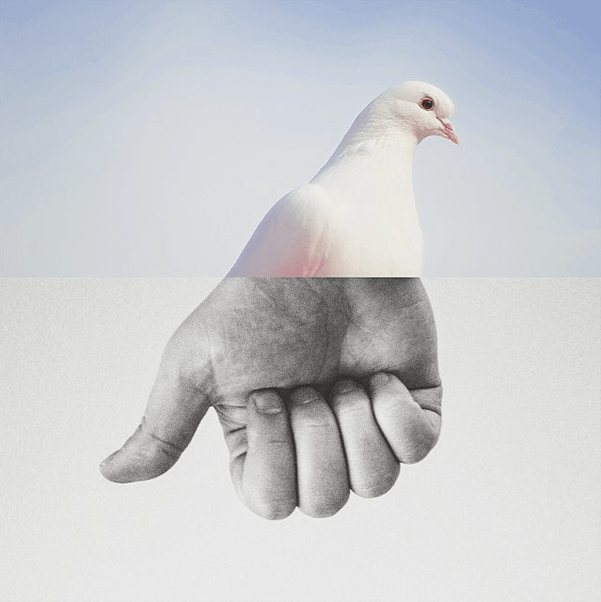 Transformer; current - photos of people, any objects and animals; transformer - we make up a single object from two photographs according to the principle of harmony of form; tester - weird, funny, smart. Peeped at Stephen Mcmennamy, illustration Daily sketchups
Transformer; current - photos of people, any objects and animals; transformer - we make up a single object from two photographs according to the principle of harmony of form; tester - weird, funny, smart. Peeped at Stephen Mcmennamy, illustration Daily sketchups
2. Mind map
Description of the method. A mental map or mind mapping is a technique for visualizing thinking. Maps are needed to develop topics, search for ideas, systematize knowledge.
Working mechanism. Take a sheet of paper or launch an online map editor, write the main topic or word in the middle of the sheet, draw branches with associations from the topic. Someone writes only in words, someone adds simple drawings, icons.
This is what the cards look like:
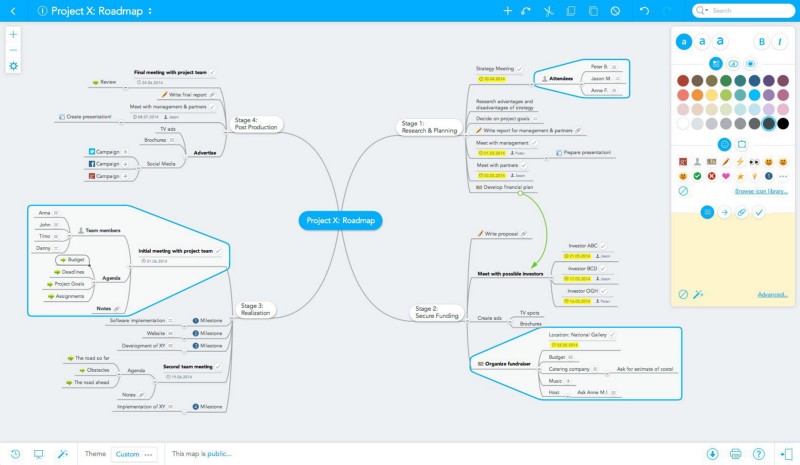 Screenshot from online map editor Mindmeister
Screenshot from online map editor Mindmeister
 One of the cards in my notebook
One of the cards in my notebook
 Time management card. MindTools
Time management card. MindTools
My Mapping Approach:
- Analysis of own associations related to the topic;
- I expand the list of words in the map using associative dictionaries: sociation.org, wordassociations.ru, www.slovesa.ru;
- I am typing the main words and associations in Pinterest and Google image, looking for images and words in pictures. In Pinterest, I sort through the tags, add the words #illustration or #graphic_design to the topic.
Services for working with cards:
- Mindmeister.com is a nice online map editor. I use it. There are limitations in the free version;
- Mind42.com - haven't tried it, but love it from mappers;
- Mindnode.com - map editor for Apple technology.
More details about the method are written on Habrahabr in the Mind Mapping article, or how to make your brain work better.
3. A systematic approach to associations
The methodology is similar to the mind mapping method. Found on the blog of Nate Williams, an American illustrator, in this entry.
Brief translation of the article with the mechanism of work:
1. You have a topic, a task. Describe the topic in 2-4 main words. For example, the theme - "empowering teachers through technology". Key words: empowerment, teacher, technology.
2. We select associations for each word: 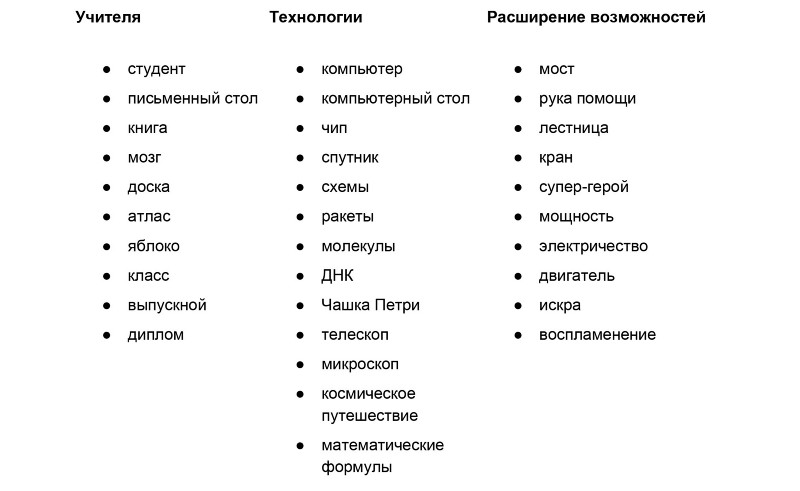
3. We connect one association from each column into sentences:
- crane operated teacher, lowers light bulbs in the head of a student;
- student climbs up DNA ladder to draw light bulbs on the board;
- students and teachers go to bridge from computers to the moon.
We visualize the proposals:
 "Bridge to Another World" Students and teachers cross the bridge of computers to the moon.
"Bridge to Another World" Students and teachers cross the bridge of computers to the moon.
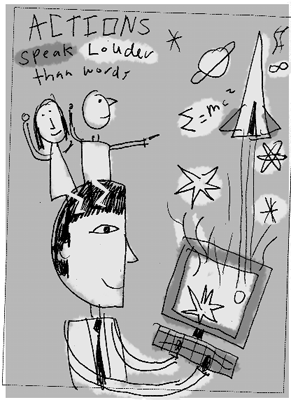 "Riding on the head". The teacher's head is a vehicle that takes students to new knowledge with the help of technology / computer
"Riding on the head". The teacher's head is a vehicle that takes students to new knowledge with the help of technology / computer
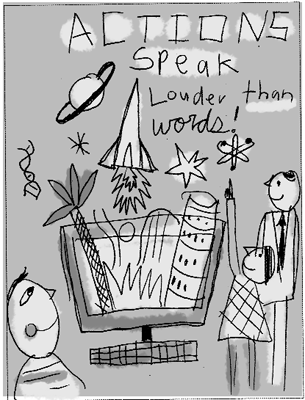 "Explosion of knowledge". Computer, portal metaphor
"Explosion of knowledge". Computer, portal metaphor
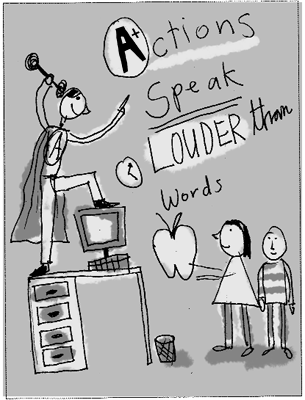 "Super Teacher". The teacher in a heroic pose (standing at the computer) inspires students
"Super Teacher". The teacher in a heroic pose (standing at the computer) inspires students
 The illustration is ready!
The illustration is ready!
4. Tropes and stylistic figures
Description of the method. The whole world is a text, and it consists of signs and semantic units. Semiotics deals with the study of signs and meanings, the rules of communication. V. Melamed popularizes this method in illustration. An illustration is a text, which means that the rules of speech, stylistic figures of speech apply in it.
“A good illustration can be retold in words”
V. Melamed
Working mechanism. Recall literary tropes: metaphor, metonymy, synecdoche, epithet, hyperbole, dysphemism, pun, litote, simile, paraphrase, allegory, personification, irony, pathos, sarcasm, euphemism, anaphora, gradation, antithesis, omission, parallelism, inversion. Find the definitions on Google if you forgot.
There are two options for working with this method. First, reinforce your idea with tropes. The second option is to choose paths that will create a visual metaphor for your idea.
Implementation of trails in graphics:  The metaphor of a flight of fancy is revealed through an elegant comparison of an airplane wing and a book. Jungho Lee, illustration for book "Promenade"
The metaphor of a flight of fancy is revealed through an elegant comparison of an airplane wing and a book. Jungho Lee, illustration for book "Promenade"
 Sarcasm. Who controls whom, who is the master of his life?Pawel Kuczynski, pawelkuczynski.com
Sarcasm. Who controls whom, who is the master of his life?Pawel Kuczynski, pawelkuczynski.com
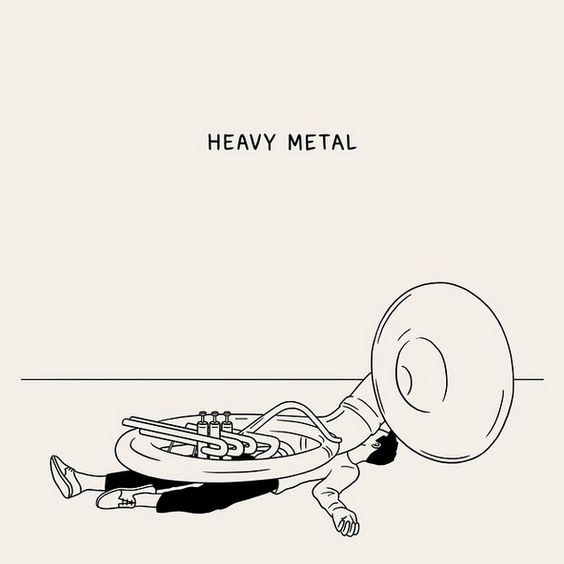 Hyperbole, pun. Tuba weight exaggeration and word play. Matt Blease, mattblease.com
Hyperbole, pun. Tuba weight exaggeration and word play. Matt Blease, mattblease.com
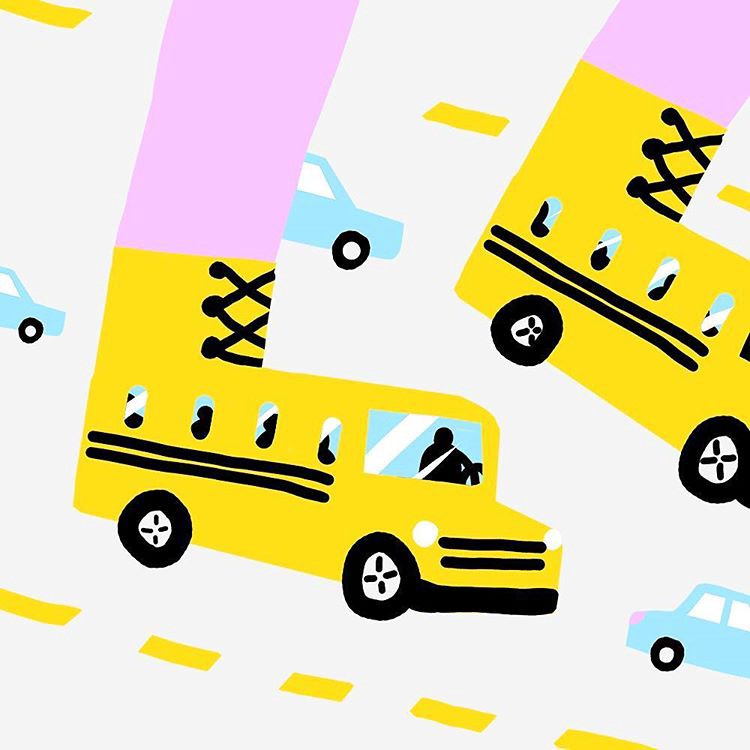 Litota, pun, comparison. Timberland bus and boots on the way. Daily sketchups
Litota, pun, comparison. Timberland bus and boots on the way. Daily sketchups
 Gradation, inversion, hyperbole, pun. The professor synthesized a giant mosquito, which he tries to kill without seeing that he has already increased in size. Who's catching who now? Brecht Vandenbroucke, brechtvandenbroucke.blogspot.com
Gradation, inversion, hyperbole, pun. The professor synthesized a giant mosquito, which he tries to kill without seeing that he has already increased in size. Who's catching who now? Brecht Vandenbroucke, brechtvandenbroucke.blogspot.com
 Antithesis, metonymy. Union of cheerful and boring, plain and colorful.Broke Davis, itistheworldthatmadeyousmall.com
Antithesis, metonymy. Union of cheerful and boring, plain and colorful.Broke Davis, itistheworldthatmadeyousmall.com
5. Using a different style, technique, material
Description of the method and mechanism of work. The fact is that the choice of material, style, tool may already be a solution to the problem.
“There was a lot of time in Britain to make us do things with our own hands. Because often the right choice of tool is already the solution to the problem, ”- Vladimir Ayuev in an article about training designers in Britain.
 Herbal tea for supporters healthy lifestyle life "Tweet" (Marina Apevalina)
Herbal tea for supporters healthy lifestyle life "Tweet" (Marina Apevalina)
 Poster (Tanya Lazareva, Stas Neretin), Moscow anthill (Raushan Sultanov), Poster (Maria Zaitseva)
Poster (Tanya Lazareva, Stas Neretin), Moscow anthill (Raushan Sultanov), Poster (Maria Zaitseva)
 Toilettering (Arthur Lebsak), Poster (Raushan Sultanov)
Toilettering (Arthur Lebsak), Poster (Raushan Sultanov)
 Posters for Izhevsk Pecha-Kucha. Materials and tools (from left to right): digital illustration; 3d graphics; homemade cookies. (Sasha Bogatov)
Posters for Izhevsk Pecha-Kucha. Materials and tools (from left to right): digital illustration; 3d graphics; homemade cookies. (Sasha Bogatov)
Besides hands, there are wonderful tools that we miss out on in the digital environment. Try to work with 3D graphics, video, look towards interactive installations, animation, sound design, mapping, web illustration. Ownership of tools expands your language in which you speak with the viewer, customer, audience. Again, the choice of tool can suggest a solution to a problem, reinforce a visual metaphor, or become its backbone.
Interaction of new technologies and the world of illustration:
1. The extraordinary news resource "My friend, you are a transformer" published a special project with cool web illustrations: taxi.batenka.ru.
2. The Mars Center in Moscow presented this year an experimental exhibition "Metaforms". Well-known street art artists of Russia have transferred their works to the virtual environment. You can see the work done with the help of virtual reality helmets.
Teaser for the opening of the exhibition "Metaforms"
3. Dmitry Karpov enthusiastically talks about the benefits of mastering the Cinema 4d program, where you can solve any visual problems more interestingly, create complex shapes, and customize the entire environment.
4. Another way to expand your toolbox - work with sculpture, plastic
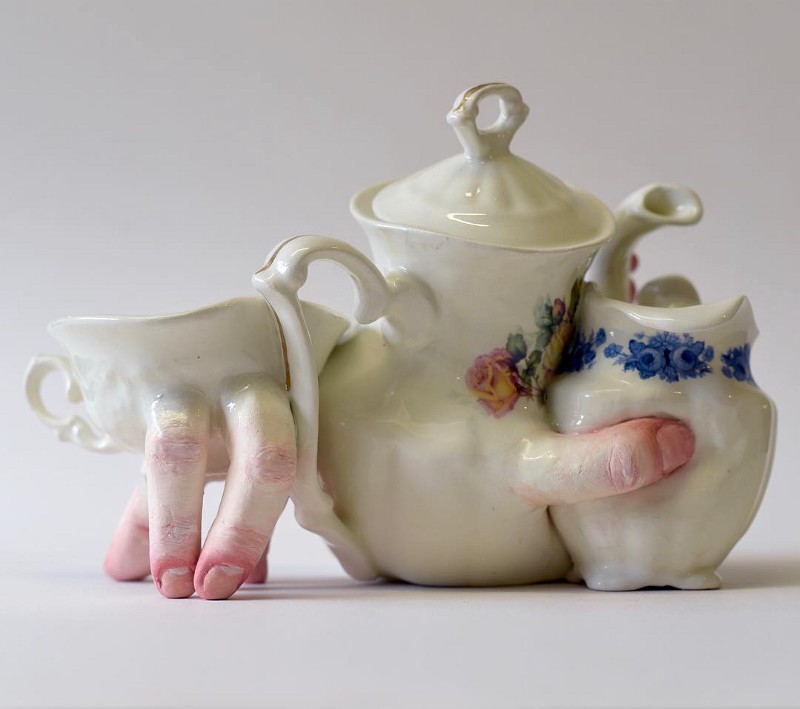 "Hugs" by Ronit Baranga, ronitbaranga.com
"Hugs" by Ronit Baranga, ronitbaranga.com
5. Visual experiment by Danil Krivoruchko showing the connection of video and coding using neural network algorithms
6. Another example of crossbreeding book illustration and web technologies in the An Awesome Book project!
 One of the illustrations from the An Awesome Book!
One of the illustrations from the An Awesome Book!
6. Synesthesia
Description of the method. Synesthesia - the ability to perceive the world with the senses, while using the description of sensations from the world of other senses. Examples: color hearing, perceiving certain colors when seeing letters, the smell of a Seven Nation Army song by The white stripes, the taste of The Simpsons.
V. Melamed talks about how to include synesthesia in the arsenal of creative tools in the lecture of the same name.
The mechanism of work on the example of synesthesia analysis:
1. Hearing. How to make an illustration rustle, buzz, rattle like an old refrigerator?
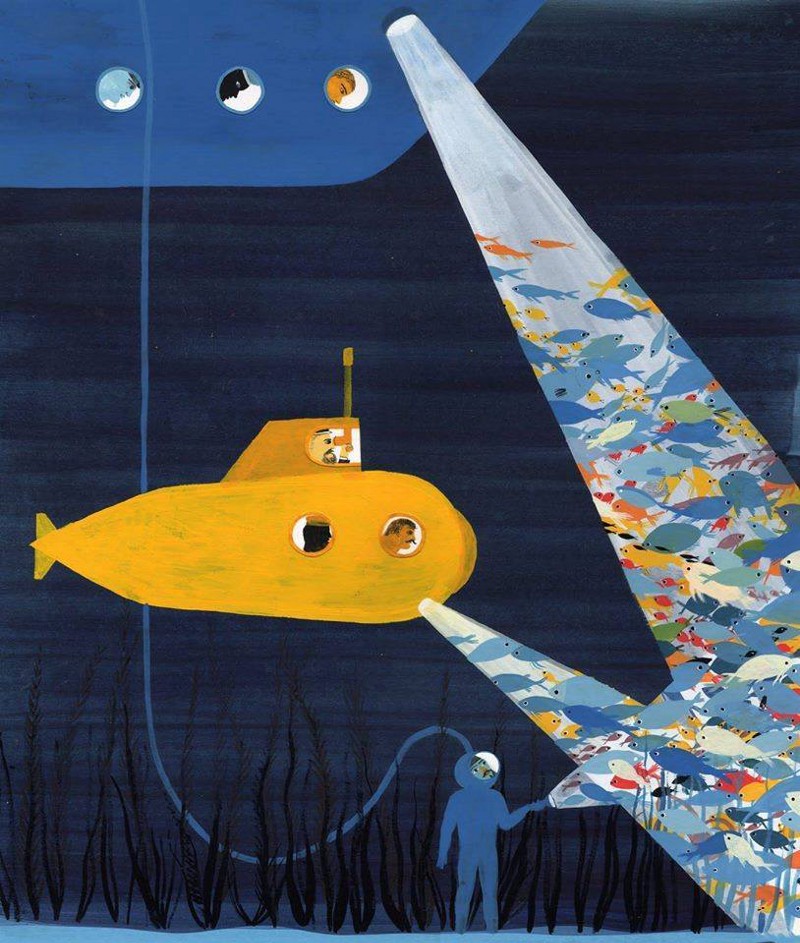 Transferring the feeling of pitch silence on the seabed and the appearance of noise in the form of fish. Valerio Vidali
Transferring the feeling of pitch silence on the seabed and the appearance of noise in the form of fish. Valerio Vidali
 Transmission of a musical buzz through the melody and mosquito sign. Daily sketchups
Transmission of a musical buzz through the melody and mosquito sign. Daily sketchups
2. Smell. Can a picture smell sweet like a rose, or stink like sweat?
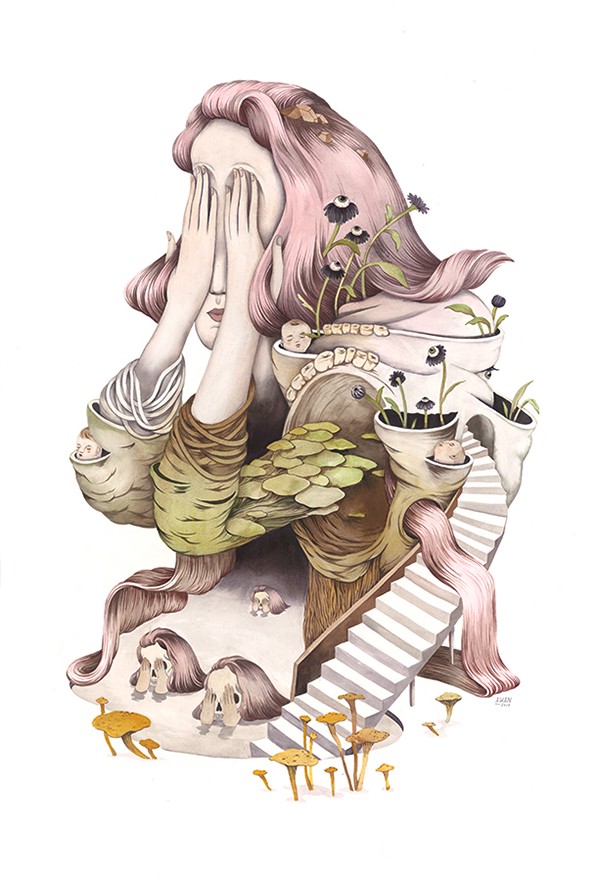 The smell of swamps, lilies, mustiness in the work of Andrea Wan, Feeling sweet cool, strawberry soda in summer, or champagne. Monica Ramos, monramos.com
The smell of swamps, lilies, mustiness in the work of Andrea Wan, Feeling sweet cool, strawberry soda in summer, or champagne. Monica Ramos, monramos.com
4. Touch. Is it possible to convey tactile sensations visually, to feel silk or turtle skin?
 Prickly illustration, moss is felt somewhere. Henry McCausland
Prickly illustration, moss is felt somewhere. Henry McCausland
5. Muscular feeling or kinesthesia. Can a picture destroy your vestibular apparatus, make you dizzy?
 Imagine yourself in the place of one of the girls, it becomes silly. Weightlessness. Javi Aznarez, javiaznarez.blogspot.com
Imagine yourself in the place of one of the girls, it becomes silly. Weightlessness. Javi Aznarez, javiaznarez.blogspot.com
6. Sense of time. How about feeling the fluidity of time in a picture?
 We freeze, we wait. How long will this mockery in pink colors last? Brad Holland bradholland.net
We freeze, we wait. How long will this mockery in pink colors last? Brad Holland bradholland.net
7. Personification of the theme
Description of the method. We give our idea a human face.
Working mechanism. Imagine that our idea, theme, product, main word, text - person. We give this person a character, determine his properties, manners, what he is wearing, what he loves and hates. Next, we start looking for a visual solution that would describe our object.
Comedy personification of Mac and PC images
I did not find the roots of the method, but the idea was overheard in the lecture " brand typography» Mikhail Shishkin from Shishki branding agency.
Brand - image in the head of the audience. He speaks by means of visual communications in a certain language, tone with the audience. Language and tone - used images, typography, font component, colors. The brand language is formed at the research stage, where a detailed portrait of the addressee, the audience is drawn up. The presentation contains examples of the selection of fonts based on the selected properties of a person's character and natural associations.
![]() A couple of slides from the presentation brand typography »
A couple of slides from the presentation brand typography »
Illustrators need to replace brand in everything they say with a visual metaphor. What is the language of this metaphor, what intonation does it speak with, what words and colors, technique? It is not difficult to see the connection with synesthesia in this method.
Apr 02
Recently we were sent two interesting books from the Mann, Ivanov and Ferber publishing house for those who love to draw and for those who love to write. The books are called: "642 ideas to write about" And . More precisely, these are not even books, but notebooks with ideas for creativity.

These books are not suitable for everyone, because we are different, and our children are not like us. Some enthusiastically draw all sorts of pictures, while others compose their own stories. These books are suitable for those who like to create in their own direction - writing or drawing.
Book "624 ideas to write about" is an assistant for the development of creativity, creative thinking and imagination. There are 642 ideas in the book (funny, weird, and unusual) and it's up to the owner of the book to continue the stories and turn them into complete stories. The pages in the book are divided into parts and each such part begins its own story.
The book is intended for adults and teenagers who like to fantasize. The book contains the following assignments:
Your cat dreams of world domination. She figured out how to switch bodies with you.
An unknown force threw you inside the computer. You need to get out.
The day did not portend anything unusual until the planet was attacked.
Another task of the book is the ability to formulate thoughts. For some tasks, a lot of space is given for creativity, and for some, a small square. This teaches to write in detail and on the topic, without creative "water".
This book can be both a simple favorite hobby and a simulator for developing writing skills. 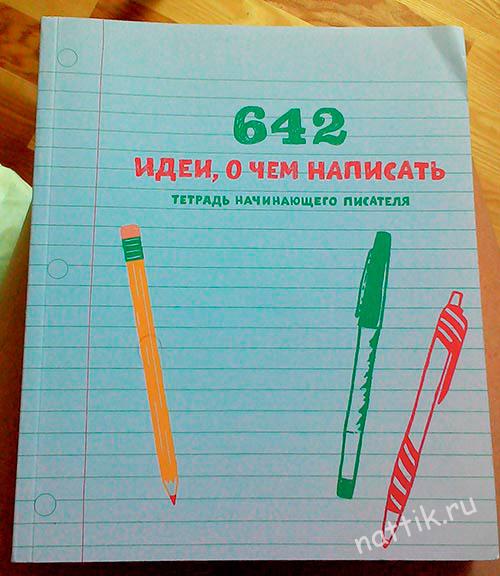
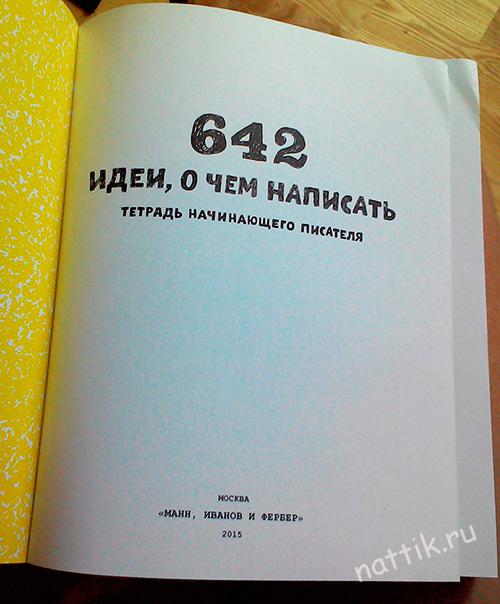


Unlike the previous book, "642 ideas to draw about" more suitable for those who like to draw. This notebook may become a favorite creative notebook, which will contain the masterpieces of the novice master. Or it can just turn into great entertainment and pastime. This book can captivate any student.
In their structure, the books are very similar, only intended for people with different interests.
This book contains 642 drawing ideas, such as:
air castle
Mirage
Time Machine
Creativity doesn't need a reason. Pick up a pencil, a wish and a book “624 ideas to draw about”, tips will help you. Unleash your creativity. After all, drawing is not only interesting, exciting, but also useful.

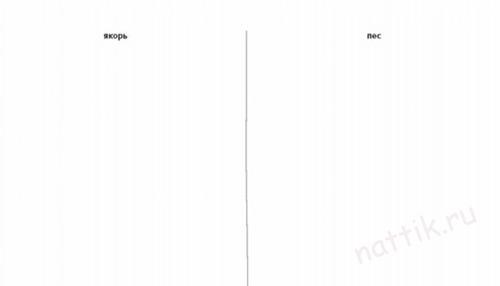
I often come across books and notebooks on the shelves for creative people with ideas, such as: “what to draw”, “what to write about”, the general essence of which is to purchase a collection of white sheets with lined pages for 600-900 rubles, not so hot convenient format. Such notebooks are somewhat similar to the “Destroy Me” series, when the pages offer the owner a dialogue with paper for the sake of a pleasant pastime. Like, do you have a lot of time and are you lonely? You do not know where to put yourself and what to do? Here I am, your notebook, draw me, I will make you need me, I will make you spend even more money and come up with new troubles for you if you yourself cannot.
I exaggerate, of course, but the essence does not change. The notebook acts as a silent interlocutor, calls for dialogue, asks to paste various paper wrappers, buy additional stickers, pencils, pens, watercolors or acrylic paints… This is all to the fact that a creative person can have “congestion” and “constipation”, but it is not at all necessary to solve them by acquiring a new creative toy. I know such plushkins and hamsters, I myself was the same, when absolutely everything cool is swept off the shelves, it is not known why it could come in handy. And it lies on the shelves for years as rubbish, losing relevance. Any notebook should be used, grow and develop with it. If you have a problem with finding an idea of what to draw, then use any generator of random numbers and words - what you gave out, then draw.
Complicate your task - use a bunch: noun + adjective + verb. For example, which + what does + where. And the more delusional the idea, the more curious it is to draw. It doesn't matter if you draw by hand or in a graphics editor. They also practice this method: open your favorite book on any page, poke your finger at any line, read and draw. Helps. Checked.
Develop imagination when reading a book - come up with a scene, take your mind off the book, draw. This is how they learn not only to copy, but also to invent something of their own, “from the head”. It is possible that you will need photo references, anatomy lessons and something else. But this is where your development is!
Real life example: I drew for several years purely for fun. Step by Step Lessons, coloring, making copies. And then I realized that I stopped at some stage, and my technique doesn’t develop in any way and doesn’t move anywhere. And gradually the motivation for creativity began to fade, less and less I took up my favorite pencils and paints. Yes, there were trips to stationery stores, and just like that, and in search of ideas. But the brought fuse was enough for a short time.
Therefore, look for new ways for yourself to develop, try to motivate yourself at least somehow for growth, master new techniques, try, do not be afraid. Set yourself some kind of goal, for example, to master the technique of drawing with ink, to complete a series of drawings in blue and red colors (or any other), to complete a series of drawings only with a pencil Green colour. Believe me, there are many creative talents hidden inside you, do not bury them!
Drawing sent by: Gambit


